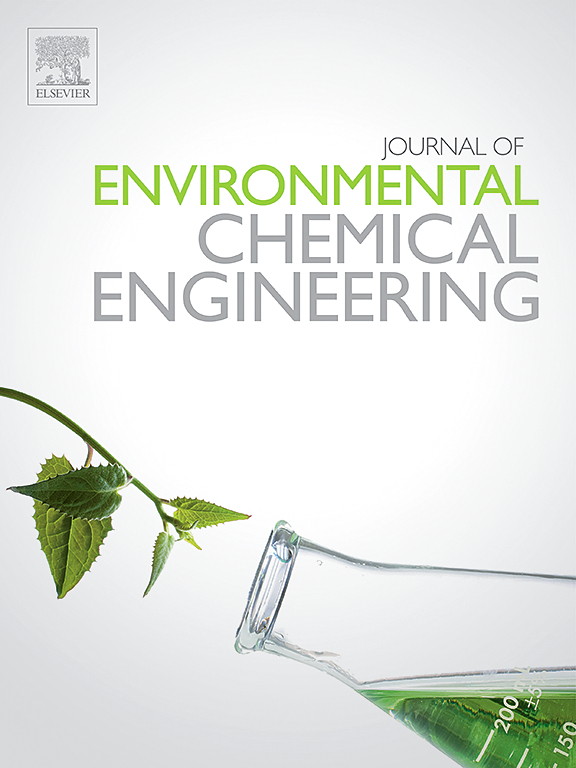Enhanced photo-electrochemical properties of phosphorus-doped ZnSxO1-x with surface PS· defect species for hydrogenation with in situ generated H+
IF 7.4
2区 工程技术
Q1 ENGINEERING, CHEMICAL
引用次数: 0
Abstract
Photocatalytic hydrogenation was successfully conducted in the present work with P-doped ZnSxO1-x catalyst to convert 4-nitrophenol (4-NP) to 4-aminophenol (4-AP) with in situ generated H+. In previous work, pure ZnSxO1-x photocatalyst exhibited its ability to evolve hydrogen. However, it cannot convert 4-NP to 4-AP completely since the generated H+ is easily reduced to H2 and released from catalyst surfaces. In this work, phosphorus was doped to ZnSxO1-x to purposely create defects to trap the generated electrons on catalyst surfaces, thus decreasing the reduction of adsorbed H+ to H2. XPS analysis indicates the emergence of positively charged and surface defects after doping P to ZnSxO1-x. When the photogenerated electron is trapped in the positively charged defects, the H+ reduction is diminished. The available H+ on catalyst surfaces can be used for a hydrogenation reaction of 4-NP to 4-AP during the photoreaction. To optimize the catalytic system, different amounts of P precursor were doped into ZnSxO1-x with a hydrothermal method at 150 °C. The as-synthesized catalysts were characterized with XRD, SEM, TEM, XPS, DRS, PL, EIS, TPC, and CV analysis. It was found that a typical catalyst (ZP-0.2–10 h) can effectively hydrogenate 30 ppm 4-NP to 4-AP in 60 min under a 150-W Xe-lamp illumination. Based on the analysis data, P doping enhances the light absorbance, photocurrent, conductivity, and photocarrier lifetime of ZnSxO1-x. The present work indicates a green hydrogenation reaction can be done by modifying a hydrogen-evolved photocatalyst. Finally, a rational hydrogenation conversion mechanism was discussed and proposed in this work.
具有表面PS·缺陷的掺磷ZnSxO1-x在原位生成氢离子加氢过程中的光电性能增强
本研究用p掺杂ZnSxO1-x催化剂进行了光催化加氢,用原位生成的H+将4-硝基苯酚(4-NP)转化为4-氨基苯酚(4-AP)。在之前的研究中,纯ZnSxO1-x光催化剂表现出出氢的能力。然而,它不能完全将4-NP转化为4-AP,因为生成的H+很容易还原为H2并从催化剂表面释放出来。在这项工作中,磷被掺杂到ZnSxO1-x中,故意制造缺陷以捕获催化剂表面上产生的电子,从而减少吸附的H+还原为H2。XPS分析表明,P掺杂ZnSxO1-x后,表面出现了带正电荷的VO··和PS·缺陷。当光生成的电子被困在带正电的缺陷中时,H+的还原作用减弱。在光反应过程中,催化剂表面可用的H+可用于4-NP加氢到4-AP。为了优化催化体系,采用水热法在150℃下将不同量的P前驱体掺杂到ZnSxO1-x中。采用XRD、SEM、TEM、XPS、DRS、PL、EIS、TPC和CV分析对合成的催化剂进行了表征。结果表明,在150w氙灯照明下,典型催化剂(ZP-0.2-10 h)可在60min内有效地将30ppm的4-NP加氢为4-AP。分析结果表明,P掺杂提高了ZnSxO1-x的光吸光度、光电流、电导率和光载流子寿命。本研究表明,通过修饰出氢光催化剂可以实现绿色加氢反应。最后,讨论并提出了合理的加氢转化机理。
本文章由计算机程序翻译,如有差异,请以英文原文为准。
求助全文
约1分钟内获得全文
求助全文
来源期刊

Journal of Environmental Chemical Engineering
Environmental Science-Pollution
CiteScore
11.40
自引率
6.50%
发文量
2017
审稿时长
27 days
期刊介绍:
The Journal of Environmental Chemical Engineering (JECE) serves as a platform for the dissemination of original and innovative research focusing on the advancement of environmentally-friendly, sustainable technologies. JECE emphasizes the transition towards a carbon-neutral circular economy and a self-sufficient bio-based economy. Topics covered include soil, water, wastewater, and air decontamination; pollution monitoring, prevention, and control; advanced analytics, sensors, impact and risk assessment methodologies in environmental chemical engineering; resource recovery (water, nutrients, materials, energy); industrial ecology; valorization of waste streams; waste management (including e-waste); climate-water-energy-food nexus; novel materials for environmental, chemical, and energy applications; sustainability and environmental safety; water digitalization, water data science, and machine learning; process integration and intensification; recent developments in green chemistry for synthesis, catalysis, and energy; and original research on contaminants of emerging concern, persistent chemicals, and priority substances, including microplastics, nanoplastics, nanomaterials, micropollutants, antimicrobial resistance genes, and emerging pathogens (viruses, bacteria, parasites) of environmental significance.
 求助内容:
求助内容: 应助结果提醒方式:
应助结果提醒方式:


